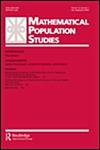年龄阶层的季节波动,以1896-1897年南俄罗斯为例
IF 1.3
3区 社会学
Q3 DEMOGRAPHY
引用次数: 0
摘要
年龄班级规模的季节性变化包括各年龄段的出生人数和死亡率。它们影响人口普查,从而影响按年龄划分的人口比率。由于它们的分析表达变得不可分割,一项以年龄为单位的衰老队列模拟显示,人口死亡率的波动不足以阻止年龄类别的波动,就像相关的出生一样,这与之前的文献所表明的相反。衰减后的放大会收敛,所达到的水平取决于相对于0至6个月出生的死亡率波动的放大。阻尼率主要取决于0-5个月的死亡率与出生时相比的放大。对1896年南俄罗斯数据的应用表明,年龄班级的规模在一年中有所不同,就像相关队列的出生人数一样,人口普查中计算的人数根据人口普查的月份变化很大。本文章由计算机程序翻译,如有差异,请以英文原文为准。
Seasonal fluctuations of age classes, with application to South Russia, 1896-1897
ABSTRACT Seasonal variations in age class sizes involve those of births and those of mortality across ages. They affect censuses and, consequently, rates involving numbers by age. As their analytical expression becomes inextricable, a simulation of aging cohorts by months of age shows that mortality oscillations for human populations are not sufficient to prevent age classes from oscillating approximately like associated births, contrary to what previous literature suggests. The amplification converges after damping, and the level reached depends on the amplification of mortality oscillations relative to births between 0 and 6 months of age. The damping rate depends mainly on the amplification of the mortality of 0–5 months compared to births. The application to 1896 South Russian data shows that age class sizes vary during the year like the births of the associated cohorts and that the numbers counted at the census vary strongly according to the month of the census.
求助全文
通过发布文献求助,成功后即可免费获取论文全文。
去求助
来源期刊

Mathematical Population Studies
数学-数学跨学科应用
CiteScore
3.20
自引率
11.10%
发文量
7
审稿时长
>12 weeks
期刊介绍:
Mathematical Population Studies publishes carefully selected research papers in the mathematical and statistical study of populations. The journal is strongly interdisciplinary and invites contributions by mathematicians, demographers, (bio)statisticians, sociologists, economists, biologists, epidemiologists, actuaries, geographers, and others who are interested in the mathematical formulation of population-related questions.
The scope covers both theoretical and empirical work. Manuscripts should be sent to Manuscript central for review. The editor-in-chief has final say on the suitability for publication.
 求助内容:
求助内容: 应助结果提醒方式:
应助结果提醒方式:


